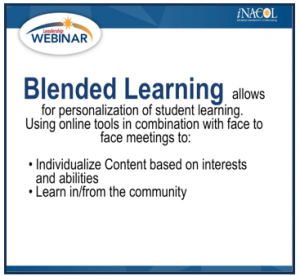Last week iNacol (inacol.org), the premiere online learning organization in the United States, completed their fall conference that focused on Blended Learning and Personalized Learning. These two areas are “trending” (as the media would say) in education.
How do we define Blended Learning? Here is one definition that sums it up well:
The definition of blended learning is a formal education program in which a student learns:
(1) at least in part through online learning, with some element of student control over time, place, path, and/or pace; (2) at least in part in a supervised brick-and-mortar location away from home; (3) and the modalities along each student’s learning path within a course or subject are connected to provide an integrated learning experience.
https://www.christenseninstitute.org/blended-learning-definitions-and-models/#sthash.buKlqMff.dpuf
Blended Learning, in particular, is becoming more accepted in schools and classroom, as an easy transition from computers in the classroom to online learning. The students’ own teacher is available part of the time for face-to-face instruction, and the online content forms some portion of the course content.
Many organizations are providing content for developing the online portion of a blended learning program, such as the Khan Academy, for example, that provides free video in many subject areas. Teachers can take this video content and use it to develop the lessons, activities, projects and assessments that make up a blended online program.
ELCC has been supporting Blended Learning for the past 3 years with Hillfield Strathallan College, where grades 6 and 8 students have been using our Blended Learning Modules, and Northmount School, where grades 4-6 have incorporated them into their program. This fall HSC will also include a Writer’s Craft Blended Module in their grade 12 courses.
These and many more Modules are available through the eLearning Consortium Canada for grades 4-12, and they provide a turnkey method of integrating Blended Learning quickly into classes. Of course, the teachers continue to be trained in the implementation of Blended Learning through the UOIT AQ Teaching and Learning with eLearning summer and fall continuing ed programs.
I am excited to see the increasing development of Blended Learning, and look forward to more of our schools embracing our Blended Modules in their classrooms. As an organization we are ready to support schools who want to learn more about Blended Learning and how to implement such a program in their own schools.
For further information be sure to contact us!








